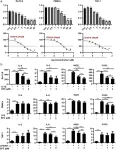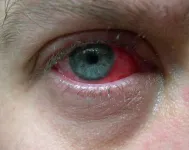(Press-News.org) Eating gradually increasing doses of store-bought, home-measured peanut butter for about 18 months enabled 100% of children with peanut allergy who initially could tolerate the equivalent of at least half a peanut to consume three tablespoons of peanut butter without an allergic reaction, researchers report. This easy-to-implement treatment strategy could potentially fulfill an unmet need for about half of children with peanut allergy, who already can tolerate the equivalent of at least half a peanut, considered a high threshold. The findings come from a trial sponsored and funded by the National Institutes of Health’s National Institute of Allergy and Infectious Diseases (NIAID) and published today in the journal NEJM Evidence.
“Children with high-threshold peanut allergy couldn’t participate in previous food allergy treatment trials, leaving them without opportunities to explore treatment options,” said NIAID Director Jeanne Marrazzo, M.D., M.P.H. “Today’s report focuses on this population and shows that a very safe and accessible form of therapy could be liberating for many of these children and their families.”
The food allergy treatments currently approved by the Food and Drug Administration were tested in children with low-threshold peanut allergy, who cannot tolerate the equivalent of even half a peanut. These treatments are designed to decrease the likelihood of a reaction to a small amount of peanut despite efforts to avoid it, as might occur with accidental exposure. This approach is not relevant to the estimated 800,000 U.S. children who may have high-threshold peanut allergy, leaving them with only one management strategy prior to the new report: peanut avoidance.
To address this need, researchers tested whether a low-cost, convenient treatment strategy could help children with high-threshold peanut allergy tolerate a much greater amount of peanut protein than they already did. The mid-stage trial involved 73 children ages 4 to 14 years. Based on parent or guardian report, nearly 60% of the children were white, 19% were Asian, 1.4% were Black, and 22% were more than one race. The study team assigned the children at random to either test the new treatment strategy or continue avoiding peanut.
Those in the peanut-ingestion group began with a minimum daily dose of 1/8 teaspoon of peanut butter. They gradually increased their dose every eight weeks up to 1 tablespoon of peanut butter or an equivalent amount of a different peanut product, such as peanut flour or candies. Dose increases took place under medical supervision at the study site. None of the children in the peanut-ingestion group needed epinephrine to treat severe allergic reactions during home dosing, and only one child needed epinephrine during a supervised dosing visit at the study site.
After undergoing the treatment regimen, the peanut-consuming children participated in an oral food challenge carefully supervised by the study team to see how much peanut butter they could eat without an allergic reaction. All 32 children who participated in the challenge could tolerate the maximum amount of 9 grams of peanut protein, the equivalent of 3 tablespoons of peanut butter. By contrast, only three of the 30 children in the avoidance group who underwent the oral food challenge after a similar amount of time in the trial could tolerate 9 grams of peanut protein. Three additional children in the avoidance group tolerated a challenge dose at least two doses greater than the amount they could tolerate at the start of the study.
The trial took place during the COVID-19 pandemic, and some families preferred to avoid indoor close contact with others at that time, so some children did not return to the study site for the oral food challenge. Using a common statistical technique to account for those missing challenge results, 100% of the ingestion group and 21% of the avoidance group tolerated at least two doses greater than they could at the outset.
Children in the peanut-ingestion group who could tolerate 9 grams of peanut protein during the oral food challenge consumed at least 2 tablespoons of peanut butter weekly for 16 weeks, then avoided peanut entirely for eight weeks. At that point, they were asked to return to the study site for a final oral food challenge.
Twenty-six of the 30 treated children (86.7%) who participated in the final challenge continued to tolerate 9 grams of peanut protein, indicating they had achieved sustained unresponsiveness to peanut. The three children in the avoidance group who could eat 9 grams of peanut protein without a reaction at the earlier challenge were considered to have developed natural tolerance to peanut. Analyzing these outcomes and including all 73 children who began the trial, regardless of whether they participated in the final challenge, investigators found that 68.4% of the peanut-ingestion group achieved sustained unresponsiveness, while only 8.6% of the avoidance group developed natural tolerance.
Based on these encouraging results, the investigators want to learn if the same treatment strategy would work for food allergens other than peanuts. Future follow-up is needed to determine the therapy’s effectiveness at inducing long-lasting tolerance of peanut.
Scott H. Sicherer, M.D., and Julie Wang, M.D., led the trial, which took place at the Elliot and Roslyn Jaffe Food Allergy Institute in Mount Sinai Kravis Children’s Hospital, New York. Dr. Sicherer is director of the Institute and the Elliot and Roslyn Jaffe Professor of Pediatric Allergy and Immunology. He is also chief of the Division of Allergy and Immunology in the Department of Pediatrics and medical director of the Clinical Research Unit in the ConduITS Institute for Translational Sciences at Icahn School of Medicine at Mount Sinai. Dr. Wang is a professor of pediatric allergy and immunology in the Elliot and Roslyn Jaffe Food Allergy Institute.
More information about the clinical trial, called the CAFETERIA study, is available at ClinicalTrials.gov under study identifier NCT03907397.
Reference: SH Sicherer et al. Randomized trial of high dose, home measured peanut oral immunotherapy in children with high threshold peanut allergy. NEJM Evidence DOI: 10.1056/EVIDoa2400306 (2025).
NIAID conducts and supports research—at NIH, throughout the United States, and worldwide—to study the causes of infectious and immune-mediated diseases, and to develop better means of preventing, diagnosing and treating these illnesses. News releases, fact sheets and other NIAID-related materials are available on the NIAID website.
About the National Institutes of Health (NIH): NIH, the nation's medical research agency, includes 27 Institutes and Centers and is a component of the U.S. Department of Health and Human Services. NIH is the primary federal agency conducting and supporting basic, clinical, and translational medical research, and is investigating the causes, treatments, and cures for both common and rare diseases. For more information about NIH and its programs, visit https://www.nih.gov/.
NIH...Turning Discovery Into Health®
END
Nature is full of impostors, and many of them are found in the insect world. Certain species, such as the bee fly or the ant spider, are experts at misdirection and their ability to confuse predators or prey is on a par with that of John Travolta in Face/Off and Arya Stark in Game of Thrones. However, never before has a blow fly been observed successfully living in cognito among termites.
Now, for the first time ever, an international study led by the Institute of Evolutionary Biology (IBE), a joint centre of the Consejo Superior de Investigaciones Científicas (CSIC) (the Spanish National Research Council (CSIC)) and Pompeu Fabra University (UPF), ...
Background and objectives
Oral contraceptive pills (OCPs) are commonly used for contraception, but their long-term effects on oxidative stress, lipid profiles, and liver function remain unclear. This study aimed to evaluate the impact of intermediate-term OCP use (Yasmin) on oxidative stress, lipid profile, and liver function, with particular emphasis on antioxidant markers, lipid metabolism, and hepatic enzyme activity, to better understand the potential metabolic and hepatic effects.
Methods
A case-control study was conducted in Maysan Governorate, Iraq, involving 150 women (100 OCP users and 50 ...
A first-of-its-kind study provides a snapshot of the substantial mental health burden on nurses around the world. Published in the journal International Nursing Review, the research documents the impact of three years of intense working conditions brought on by the COVID-19 pandemic.
“Our study describes how nurses are affected by stressors in their workplace and shows how the stress carries over into their home life. The personal losses from the pandemic complicate this picture as there could easily be lingering grief in a third of the workforce,” said Allison Squires, ...
Doctors at Queen Mary University of London, Barts Health NHS Trust, and University College London have led the development of a simple, minimally invasive Targeted Thermal Therapy (Triple T) that has the potential to transform medical management of a common, but commonly overlooked, cause of high blood pressure.
This breakthrough, published today in The Lancet, could, after further testing, help millions of people worldwide who currently go undiagnosed and untreated.
In the UK, Triple T, known scientifically as endoscopic ultrasound-guided radiofrequency ablation, was rigorously tested, in collaboration with researchers from ...
WASHINGTON - In our digital times as we are inundated with YouTube videos, memes and social media, satire is everywhere, but it can be more damaging to people's reputations than direct criticism, according to research published by the American Psychological Association.
Seemingly innocuous satire may be more harmful than direct criticism because it can dehumanize people and reduce them to caricatures, the study found. The research was published online in the Journal of Experimental Psychology: General.
“Most people think satire is just humorous and playful, but dehumanization exists on a spectrum and can include things like forgetting ...
Background and objectives
Protein disulfide isomerases (PDIs) are essential enzymes that facilitate the proper folding of proteins and maintain protein quality within the endoplasmic reticulum. Dysregulation of PDIs has been correlated with numerous disorders, including cancer and rheumatoid arthritis (RA). E64FC26 (EFC), a small molecule that inhibits a wide range of PDI family members, has shown promise as a therapeutic agent in oncology. However, its effects on RA have not yet been studied. This research investigates the efficacy of EFC as a potential treatment for RA.
Methods
To investigate EFC’s effects on RA fibroblast-like ...
Dr. Ha Yoon-Cheol's team at KERI's Next Generation Battery Research Center has developed an 'enhanced coprecipitation method' that enables faster and higher-quality production of lithium superionic conductors for ASSBs.
ASSB replaces the ‘electrolyte’, which transfers ions between the anode and cathode, with a solid instead of a liquid, significantly reducing the risk of fire or explosion..
Solid electrolytes are difficult to manufacture and expensive. However, in 2021, Dr. Ha Yoon-Cheol's team garnered significant attention by proposing the 'coprecipitation method', ...
The rapid melting and thinning of the Arctic ice have sparked serious concerns in the scientific community. In addition, sea ice thickness also has decreased, which makes ice cover more vulnerable to warming air and ocean temperature.
Understanding the ecological role of sea ice in the Arctic is crucial, particularly because the extent of sea ice in the region has been decreasing at an unprecedented rate. What would happen to the Arctic marine ecosystem if the sea ice melted even faster? To answer these questions, a long-term monitoring and data collection system is necessary in the harsh Arctic environment.
However, ...
Older adults who didn’t have enough savings to cover emergency expenses during the early months of the COVID-19 pandemic faced another surprising problem: higher levels of loneliness.
In a new study, researchers at The Ohio State University found that adults over the age of 65 faced increases in loneliness during the pandemic, regardless of income level or wealth.
But those who said they would have to use a credit card to pay off an emergency expense over time were more likely to report high levels of loneliness.
“Our ...
Graft-versus-host disease (GVHD) is a common and severe complication that occurs after stem cell transplantation, where the donor’s immune cells attack the recipient’s tissues. Ocular manifestation of GVHD is among the most challenging to treat, often leading to chronic inflammation and corneal tissue damage, which can result in loss of vision. Conventional treatments, including corticosteroids, are frequently used to manage ocular inflammation associated with GVHD. However, these therapies come with significant side effects, including the risk of glaucoma and other ocular complications.
Mesenchymal stromal cells (MSCs), a heterogeneous population of cells present in various ...




